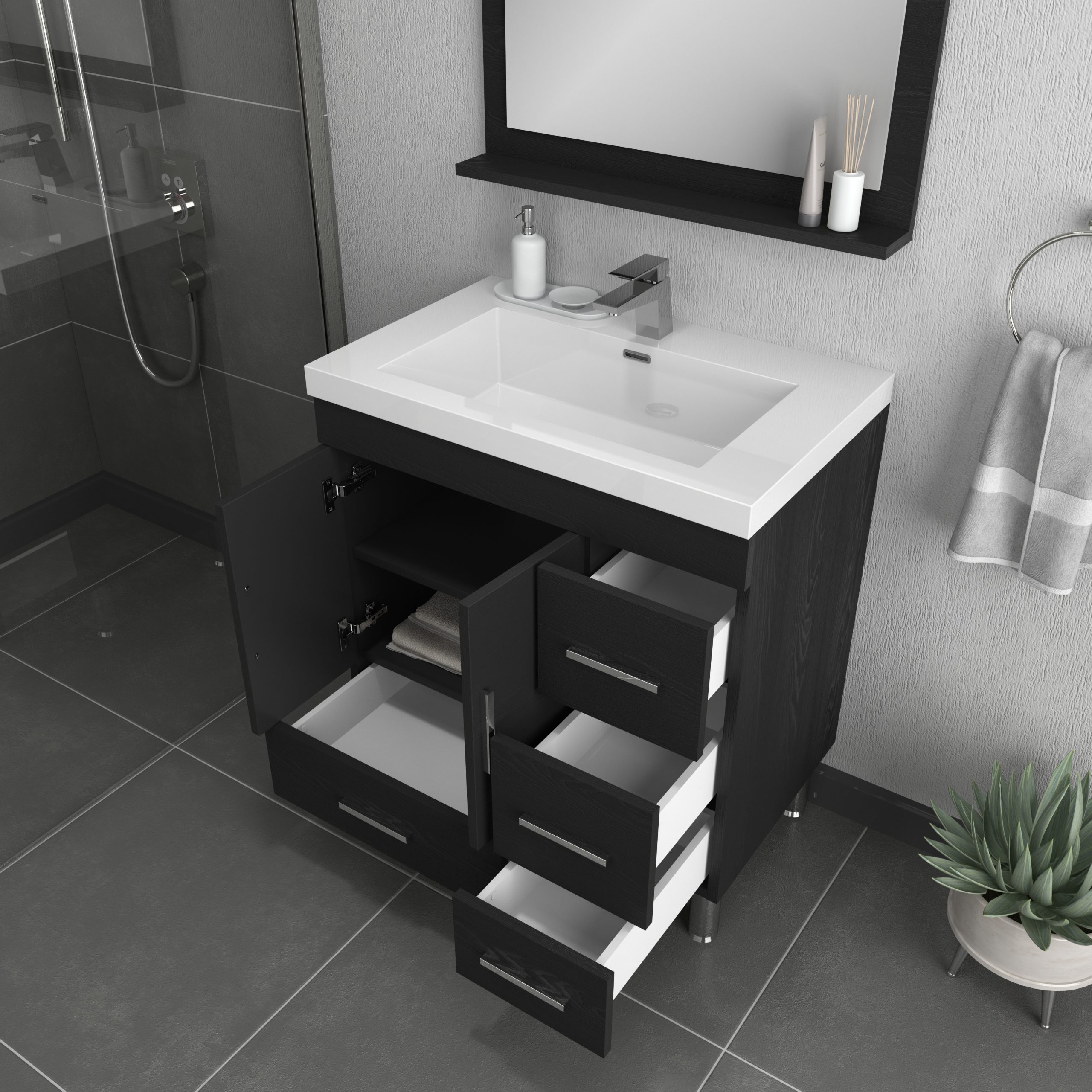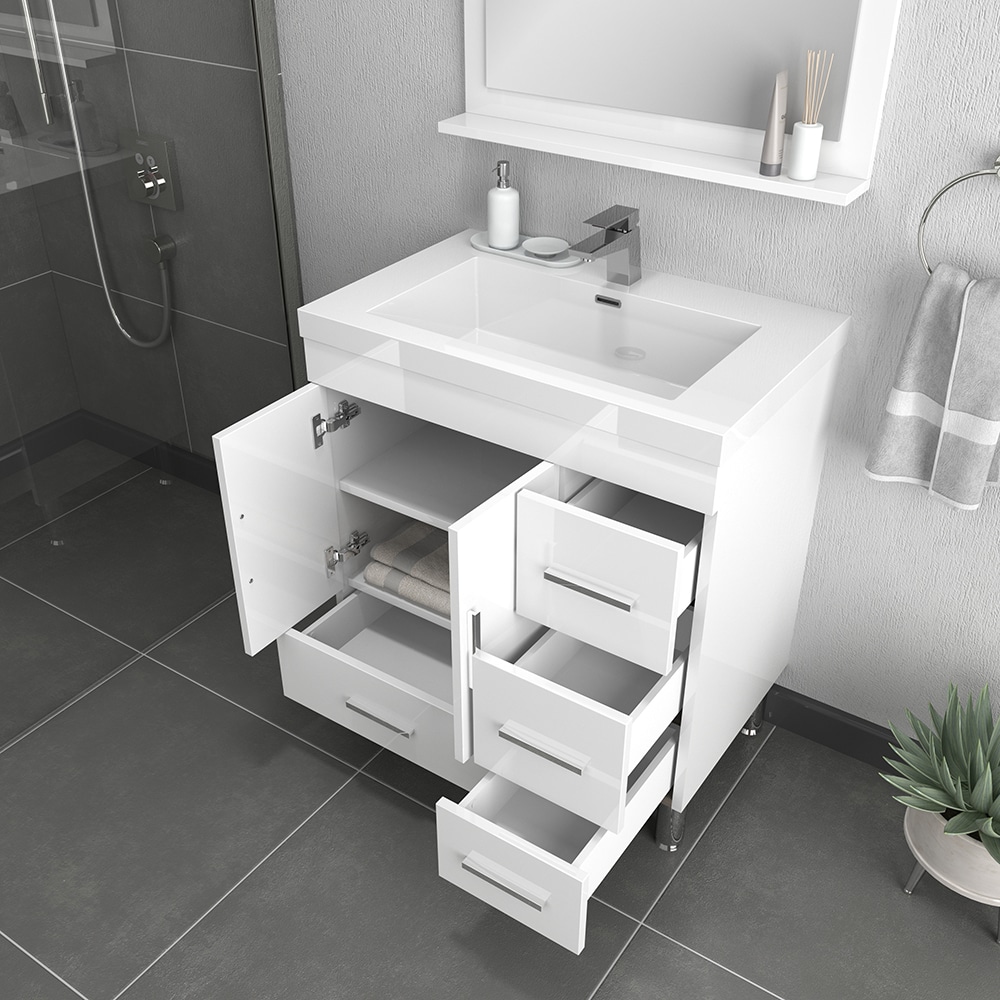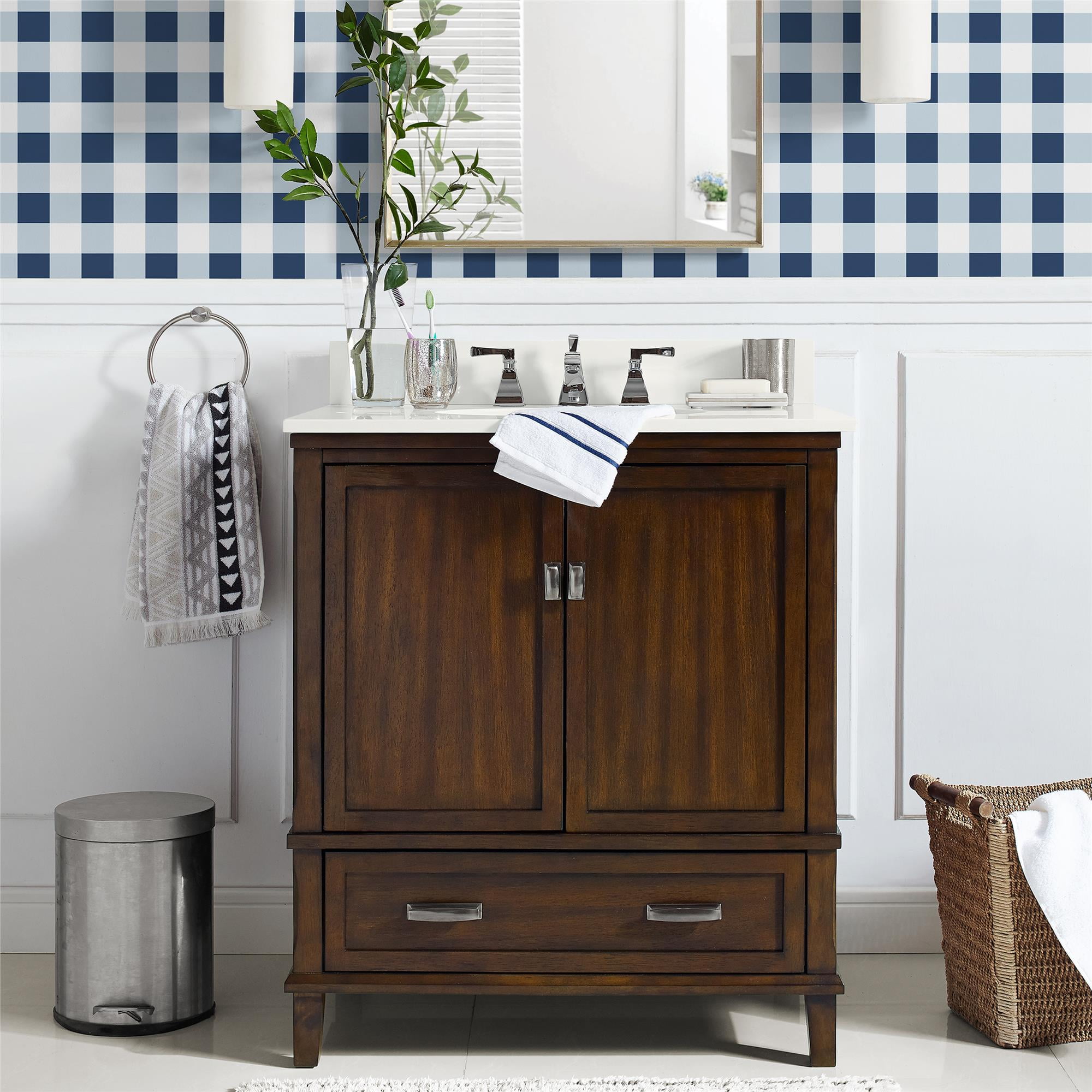Choosing the Right 30 Inch Bathroom Vanity

A 30-inch bathroom vanity is a popular choice for smaller bathrooms, offering a balance between functionality and space efficiency. While it may seem like a small size, a well-designed 30-inch vanity can still accommodate essential bathroom fixtures and provide ample storage space.
Advantages and Disadvantages of a 30-Inch Vanity
A 30-inch vanity offers several advantages, including:
- Space-Saving: A 30-inch vanity is ideal for smaller bathrooms, as it takes up less floor space than larger vanities.
- Cost-Effective: 30-inch vanities are generally more affordable than larger vanities, making them a budget-friendly option.
- Versatile: They can be incorporated into various bathroom styles, from traditional to modern.
However, there are also some disadvantages to consider:
- Limited Storage: A 30-inch vanity may have less storage space compared to larger vanities.
- Smaller Sink: The sink size may be limited, potentially affecting the overall functionality.
Factors to Consider When Choosing a 30-Inch Vanity for a Small Bathroom
When selecting a 30-inch vanity for a small bathroom, several factors are crucial to ensure functionality and aesthetics:
- Storage Needs: Assess your storage requirements. If you need ample storage, consider a vanity with drawers, cabinets, or a combination of both.
- Sink Style: Choose a sink that complements the vanity size and bathroom style. Popular options include vessel sinks, undermount sinks, and drop-in sinks.
- Countertop Material: The countertop material should be durable, easy to clean, and aesthetically pleasing. Popular choices include granite, marble, quartz, and laminate.
Popular 30-Inch Vanity Styles, 30 inch bathroom vanity with drawers
30-inch vanities are available in a variety of styles to suit different bathroom aesthetics. Here are some popular options:
- Traditional: Traditional vanities typically feature ornate details, such as carvings, raised panels, and decorative hardware. They often have a warm and inviting feel.
Example: A 30-inch vanity with a cherry wood finish, raised panels, and brass hardware.
- Modern: Modern vanities are characterized by clean lines, minimalist designs, and sleek finishes. They often feature geometric shapes and bold colors.
Example: A 30-inch vanity with a white lacquered finish, a rectangular countertop, and chrome hardware.
- Farmhouse: Farmhouse vanities embrace a rustic and cozy aesthetic. They often feature distressed wood finishes, open shelving, and metal accents.
Example: A 30-inch vanity with a reclaimed wood finish, a farmhouse-style sink, and black iron hardware.
Materials Used for 30-Inch Vanities
30-inch vanities are constructed from various materials, each with its advantages and disadvantages:
- Wood: Wood vanities offer a natural and elegant look. They are durable and can be customized to match different bathroom styles.
Pros: Natural beauty, durability, customizable.
Cons: Can be expensive, susceptible to moisture damage if not properly sealed. - Laminate: Laminate vanities are a budget-friendly option that offers a wide range of colors and patterns. They are also durable and easy to clean.
Pros: Affordable, durable, easy to clean.
Cons: May not be as aesthetically pleasing as wood or natural stone. - Acrylic: Acrylic vanities are known for their sleek and modern look. They are also non-porous, making them resistant to stains and moisture.
Pros: Sleek and modern, stain-resistant, moisture-resistant.
Cons: Can be susceptible to scratches, may not be as durable as wood or laminate.
Features and Functionality of a 30 Inch Bathroom Vanity

A 30-inch bathroom vanity offers a practical and stylish solution for smaller bathrooms. Choosing the right vanity involves considering not only its size but also its features and functionality. Let’s explore the key elements that contribute to a functional and aesthetically pleasing 30-inch bathroom vanity.
Types of Drawers and Storage Compartments
The drawers and storage compartments in a 30-inch vanity play a crucial role in maximizing storage space. Common types of drawers include:
- Soft-Close Drawers: These drawers feature a mechanism that slows down the closing motion, preventing slamming and ensuring a quiet and smooth operation. Soft-close drawers enhance the overall user experience and extend the life of the drawer hardware.
- Full-Extension Drawers: These drawers extend fully, allowing for easy access to the entire contents. Full-extension drawers are particularly useful for organizing larger items or items stored in the back of the drawer.
- Dovetail Drawer Boxes: Dovetail joints are a traditional woodworking technique that creates strong and durable drawer boxes. These joints are known for their strength and stability, ensuring that the drawers can withstand years of use.
In addition to drawers, 30-inch vanities often include:
- Open Shelves: Open shelves provide convenient storage for frequently used items such as towels, toiletries, or decorative items. They offer easy accessibility and can be styled to enhance the vanity’s aesthetic appeal.
- Cabinets: Cabinets offer enclosed storage for items that need to be hidden away or protected from dust. They are particularly useful for storing cleaning supplies, extra towels, or other bathroom essentials.
Importance of Soft-Close Drawers and Doors
Soft-close drawers and doors are an essential feature for a smooth and quiet bathroom experience. The soft-close mechanism ensures that drawers and doors close slowly and silently, preventing slamming and reducing noise levels in the bathroom. This feature not only enhances the user experience but also extends the life of the hardware, as the slow closing motion reduces wear and tear on the hinges and drawer slides.
Sink Styles for 30 Inch Vanities
30-inch vanities offer a range of sink styles to complement various bathroom designs and preferences. The most common sink styles include:
- Undermount Sinks: Undermount sinks are seamlessly integrated into the countertop, creating a clean and modern look. The absence of a visible rim allows for easy cleaning and a sleek aesthetic. However, undermount sinks can be more expensive to install and may require a specific countertop material.
- Vessel Sinks: Vessel sinks are placed on top of the countertop, creating a dramatic and visually appealing focal point. They are available in a wide range of materials, shapes, and sizes, offering ample design flexibility. However, vessel sinks can be more challenging to clean and may limit countertop space.
- Drop-in Sinks: Drop-in sinks are installed into a cutout in the countertop, offering a classic and straightforward installation. They are generally more affordable than undermount or vessel sinks and are readily available in various styles. However, drop-in sinks can create a less sleek appearance due to the visible rim.
Countertop Materials for 30 Inch Vanities
The countertop material for a 30-inch vanity plays a crucial role in its durability, maintenance, and aesthetic appeal. Here’s a comparison of common countertop materials:
| Material | Durability | Maintenance | Aesthetics |
|---|---|---|---|
| Granite | Highly durable, scratch-resistant, heat-resistant | Requires sealing periodically, prone to staining | Natural stone with unique patterns and colors |
| Quartz | Durable, scratch-resistant, heat-resistant, non-porous | Easy to clean, stain-resistant | Engineered stone with a wide range of colors and patterns |
| Marble | Durable, scratch-resistant, heat-resistant | Requires sealing periodically, prone to etching and staining | Elegant and classic natural stone with unique veining |
| Laminate | Durable, scratch-resistant, water-resistant | Easy to clean, affordable | Wide range of colors and patterns, but can appear less luxurious |
Installing a 30 Inch Bathroom Vanity: 30 Inch Bathroom Vanity With Drawers

Installing a 30-inch bathroom vanity can be a rewarding DIY project, transforming your bathroom with a fresh look and improved functionality. This guide will walk you through the process step-by-step, providing you with the necessary knowledge and tips to ensure a successful installation.
Tools and Materials
The following tools and materials are essential for a successful 30-inch bathroom vanity installation:
- Level
- Measuring tape
- Pencil
- Stud finder
- Drill/Driver
- Saw (for cutting wood if necessary)
- Wrench
- Pliers
- Screwdriver
- Caulk gun
- Safety glasses
- Work gloves
- 30-inch bathroom vanity
- Sink
- Countertop
- Faucet
- Drain assembly
- Plumbing supplies (pipes, fittings, etc.)
- Electrical supplies (wires, junction box, etc.)
- Fasteners (screws, nails, etc.)
- Silicone sealant
- Wood shims
Preparing the Installation Area
Before you begin installing your 30-inch bathroom vanity, it’s crucial to prepare the installation area.
- Clear the Area: Remove all existing fixtures, including the old vanity, mirror, and any other items in the way.
- Check for Existing Plumbing and Electrical: Locate the existing water supply lines and drain pipe. You may need to extend or adjust these lines to accommodate your new vanity. Also, locate the electrical outlet for the vanity light and ensure it’s accessible.
- Prepare the Wall: Ensure the wall is clean and free of debris. If you’re installing over existing tile, make sure the tile is sound and secure.
Assembling the Vanity
- Follow Manufacturer’s Instructions: Each vanity comes with specific assembly instructions. Carefully review these instructions before you begin.
- Assemble the Cabinet: Start by assembling the vanity cabinet according to the manufacturer’s instructions. This usually involves attaching the sides, back, and bottom panels.
- Attach the Drawers: Install the drawers and drawer slides as instructed. Ensure the drawers slide smoothly and close securely.
Installing the Vanity
- Mark the Location: Use a level and pencil to mark the desired location for the vanity on the wall. Ensure the vanity is centered and level.
- Attach the Vanity to the Wall: Secure the vanity to the wall using appropriate fasteners. It’s essential to attach the vanity to wall studs for maximum stability. If your vanity doesn’t have pre-drilled holes, use a stud finder to locate studs and drill pilot holes before installing the screws.
- Level the Vanity: Use wood shims under the vanity legs or base to ensure the vanity is perfectly level. This will prevent the vanity from tipping or wobbling.
Installing the Sink
- Attach the Sink: Once the vanity is securely installed, attach the sink to the countertop. Most sinks come with instructions specific to their installation method.
- Seal the Sink: Use silicone sealant around the edge of the sink to create a watertight seal.
Installing the Countertop
- Prepare the Countertop: If you’re installing a pre-fabricated countertop, make sure it’s cut to the correct size.
- Attach the Countertop: Secure the countertop to the vanity using appropriate fasteners. This may involve attaching the countertop with screws or using a specialized countertop adhesive.
- Seal the Countertop: Apply silicone sealant around the edge of the countertop to create a watertight seal.
Connecting the Plumbing
- Connect the Water Supply Lines: Connect the water supply lines to the faucet using appropriate fittings. Ensure the connections are tight and secure.
- Connect the Drain: Connect the drain assembly to the sink and then to the drain pipe. Ensure the drain is properly sealed and secure.
- Test for Leaks: Turn on the water supply and check for leaks at the connections. If you find any leaks, tighten the connections or replace any faulty fittings.
Connecting the Electrical
- Connect the Electrical: If your vanity has a light fixture, connect the electrical wires to the junction box. Ensure the wires are properly connected and secured.
- Test the Light: Turn on the power switch and test the vanity light to ensure it’s working correctly.
Final Touches
- Caulk the Edges: Use silicone sealant to caulk the edges of the vanity where it meets the wall to create a watertight seal.
- Clean Up: Wipe down the vanity and countertop with a damp cloth to remove any dust or debris.
30 inch bathroom vanity with drawers – So you’re thinking about a 30-inch bathroom vanity with drawers? That’s a great choice, especially if you’re tight on space. But hold on, before you start browsing for the perfect one, you might want to brush up on your “bathroom furniture vocabulary english,” like knowing the difference between a “pedestal sink” and a “vessel sink”.
Trust me, it’ll make you sound like a bathroom design pro, and you’ll be able to confidently talk to the sales guy about that 30-inch vanity with drawers like a boss!
A 30 inch bathroom vanity with drawers? That’s great for storing your fancy soaps and toothbrushes, but what about all the other stuff? You need a place for your shampoo bottles, your razors, your… well, you get the idea.
That’s where a bathroom corner rack plastic comes in handy! Just imagine, all your toiletries organized and within reach, leaving you free to admire your new 30 inch vanity. It’s a match made in bathroom heaven!